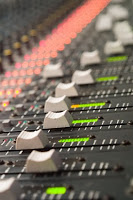--------------------
"One of the first questions that you’ll have either before or right after the audition is, “How much will I get paid?” If it’s your first touring gig, you probably don’t care so much about the income as long as you get the job, but a few months down the road it will start to bother you if you settled for a lot less than everyone else in the band. That’s why it’s a good idea to know what the expected pay range might be and when, where, and how you’ll receive it.
Touring musicians are usually paid by a weekly salary or a flat fee for the tour. You’re a hired gun, so you’ll be paid the same whether you play 2 shows or 7 shows in a week. If the tour does well and makes some extra money, you may be paid a bonus at the end, but it’s never safe to count on that happening given the touring economics that we currently live in. The Musician’s Union is usually not involved, except in the case of some orchestral player. Most of the time, you’re strictly an independent contractor doing a work for hire.
Most pay rates are normally negotiated in $250 increments. An entry level artist might only offer about $750 a week, but it could easily be as low as $500, plus per diem (which we’ll cover later in the chapter). You might decide to take a gig like this just to get your foot in the door, or the money might be immaterial because you might want to build a long term relationship with the artist.
A mid-level artist may pay between $2,000 and $2,500 a week, again negotiated in increments of $250. If you’re good enough to play with a superstar act, you can expect a weekly salary between $10,000 and $20,000. Some superstars may even pay their sidemen with a piece of each gig, which could mean a substantial financial upgrade. This usually applies only to longtime support band members though.
There’s more to what you’re getting paid than your weekly salary. You will be compensated for rehearsals, but they’re paid at a lower rate than the tour, usually half or even 1/3rd of the tour rate. An artist might say, “We need you from February 1st to Feb 14th. The tour starts on the 7th and there’ll be 3 rehearsals somewhere between the 1st and the 5th. We’re going to pay you $4,000 for the 2 weeks.” You can break that down a lot of ways, but one way to interpret it is that you’re making $1,000 for the rehearsal week and $3,000 for the tour week.
Other things that you want to know is if you’ll be paid extra for doing radio promos or clinics while on the road, and if so, how much per performance? These may be duties that fall under the category of what you’re being paid a salary for, but maybe not. And although this is almost never an issue on any legitimate tour, you’ll also want to confirm that any transportation and hotel expenses that you incur are covered if you have the slightest inkling that something doesn’t feel right in your discussions with management.
You”ll also want to know if you’ll get extra compensation if you do extra band duties. Can you act as the artist’s keyboard tech as well as play in the band in order to make some extra dough? If it saves the tour a body to house and feed, management might consider the extra compensation well worth it. As you move up the the touring food chain, this is less of an issue since you’re compensated much better and there are dedicated people for each position.
Remember that everything is open to negotiation, but some managers may say, “This is all we have. Take it or leave it.” If that’s the case, then other factors go into making your decision. You’ll have to ask yourself questions like; how much do you like the music? Will doing the gig help your career? Do you like the people involved? and is the travel easy?"
Go to the excerpt page of bobbyowsinski.com to read additional excerpts from this book and others.
----------------------------------
Help support this blog. Any purchases made through our Amazon links help support this website with no cost to you.You should follow me on Twitter for daily news and updates on production and the music business.
Don't forget to check out my Music 3.0 blog for tips and tricks on navigating social media and the new music business.



